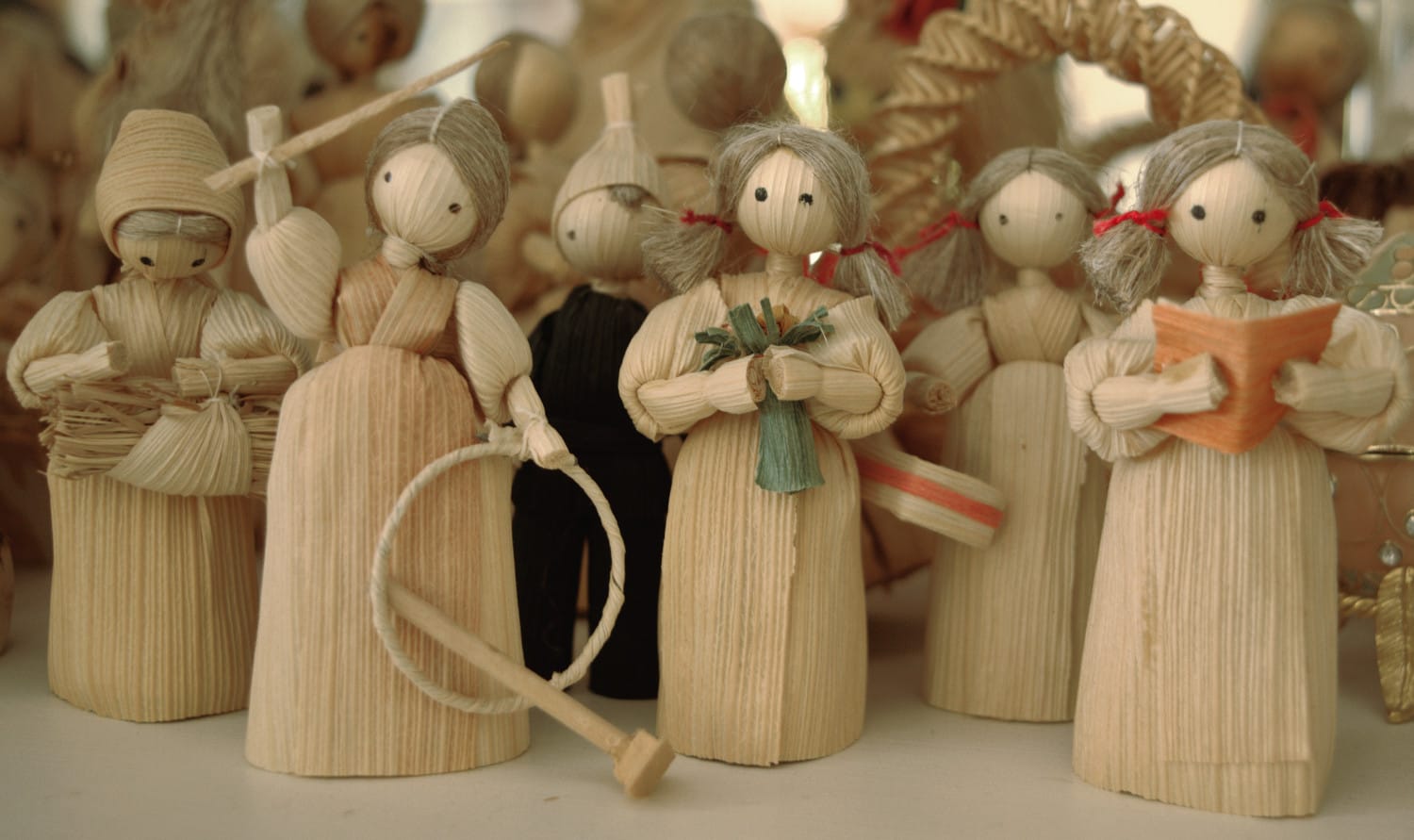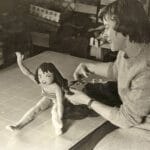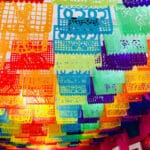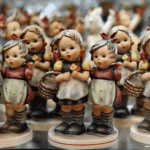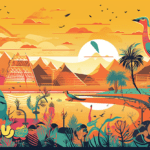Imagine yourself stepping back in time, to a world where traditions and symbols intertwine. There, in the heart of Native American culture, lies an art form as captivating as it is ancient: corn husk dolls. These aren’t mere crafts; they’re whispers from the past, each one a testament to ingenuity, tradition, and the enduring spirit of art. Join us as we trace the roots of these captivating creations, exploring their significance and the artistry that brings them to life.
History of Corn Husk Dolls
Corn husk dolls – those charming little figures made from dried corn leaves – have a history as rich and fascinating as the cultures from which they originate. While their exact origins remain shrouded in the mists of time, archaeological evidence suggests they’ve graced our world for well over a thousand years. It’s probable that their story began alongside the cultivation of corn itself, back when people in what is now the Northeastern United States first began to depend on this vital crop.
Imagine a time long before plastic toys and mass-produced playthings. Children needed toys, and what better material could there be than the very thing that sustained their families? Corn husks, plentiful, easy to work with, and surprisingly durable, were the perfect material for crafting simple yet endearing dolls.
But these weren’t just throwaway toys. Often, they were imbued with deeper meaning, each one a reflection of the cultural beliefs and traditions of its maker. Some experts theorize that corn husk dolls might have even played a role in storytelling and spiritual practices.
When European settlers arrived, they too were captivated by the simple beauty of these unique dolls. The tradition of corn husk doll making began to spread, crossing cultural boundaries and taking root in new communities. African Americans, also drawn to the craft, wove their own unique styles and traditions into the mix.
Over time, corn husk dolls evolved, their purpose expanding beyond simple playthings. They became cherished keepsakes, passed down through generations as tangible links to the past. They served as teaching tools, helping children learn about their heritage and develop important skills like weaving and crafting.
What’s truly remarkable is that corn husk dolls are still relevant today. In a world of fleeting trends and disposable everything, these humble figures continue to capture our imaginations.
For many Native American communities, corn husk dolls remain powerful symbols of cultural identity and resilience. They are a tangible representation of their deep connection to the land and a legacy of creativity that has endured for centuries. Their appeal, however, extends far beyond any one culture. Today, artists and crafters from all walks of life find inspiration in the simple elegance of corn husk dolls. They’re incorporated into modern art installations, reimagined as whimsical characters, and cherished as handmade treasures.
So, the next time you see a corn husk doll, take a moment. Appreciate its quiet beauty. Remember that you’re looking at a living tradition, a testament to human ingenuity, and a reminder that even the simplest things can hold profound meaning.
What is the symbolism of the corn husk doll?
For the Six Nations peoples, corn husk dolls are more than just cute crafts. They’re powerful symbols woven right into the fabric of their lives, reflecting their history, beliefs, and deep connection to the natural world.
One of the most striking things about these dolls is their lack of faces. This isn’t an oversight, but a deliberate choice rooted in the beliefs of the Oneida tribe. They believed that children should find joy in the doll itself, not in appearances or vanity, a beautiful reminder that sometimes, less is more.
These dolls weren’t just for play, however. They had important roles in everyday life and ceremonies as well. Think of them as multi-purpose tools that speak to the ingenuity of the Six Nations peoples. And speaking of ingenuity, crafting these dolls from corn husks highlights their resourcefulness. Nothing went to waste! Corn, a staple crop, was incredibly important to them, and the dolls became a symbol of the abundance and fertility it represented.
It’s important to note that our understanding of these dolls is still evolving. Ongoing research continues to reveal new layers of meaning and significance. The world of cultural symbolism is complex and ever-changing, and that’s what makes exploring it so fascinating!
What is the story of the corn husk dolls?
The history of corn husk dolls is a fascinating one, deeply rooted in Native American culture. Passed down through countless generations, these beautiful, handcrafted figures are more than just toys; they are vessels of stories and beliefs. While their exact origin remains lost to time, various tales offer intriguing glimpses into their creation and significance.
One such story originates from the Oneida tribe. Legend has it that the Spirit of Corn, a benevolent entity symbolizing nourishment and life itself, yearned to bring happiness to the children. In an act of profound generosity, the Spirit bestowed upon them the gift: the knowledge of crafting corn husk dolls. This act, steeped in compassion and wisdom, highlights the deep connection between the Native American people and the natural world.
When we journey to another corner of Native American culture, we encounter the Iroquois tribe and their unique perspective on the origins of corn husk dolls. For them, the Corn Spirit resided within the rustling cornfields, a powerful presence worthy of reverence and respect. Driven by this belief, they meticulously crafted corn husk dolls, not as playthings, but as sacred objects to honor the spirit’s bounty. These dolls played an integral role in their ceremonies and rituals, believed to attract good fortune and blessings.
While the stories may differ in their details, a common thread binds them: the profound respect for the Corn Spirit and its vital role in sustaining life. Corn, a staple crop for many Native American tribes, transcended mere sustenance; it embodied prosperity, spirituality, and an intrinsic connection to the earth.
Our understanding of corn husk dolls continues to evolve as researchers delve deeper into the rich history of Native American culture. Some experts believe that the dolls may have served a multitude of purposes beyond ceremonial practices. They may have acted as teaching tools for children, embodied traditional values, or even served as protective talismans. This ongoing exploration reminds us that history is not static but rather a dynamic tapestry woven from countless threads of knowledge, interpretation, and discovery.
The beauty of corn husk dolls lies not just in their craftsmanship but also in the stories they whisper across generations. They serve as a poignant reminder of the enduring legacy of Native American culture, their deep connection to nature, and the power of storytelling to transmit knowledge, beliefs, and a sense of identity. So, the next time you encounter a corn husk doll, take a moment to appreciate the rich history and cultural significance embedded within its simple yet elegant form.
What Native American tribe made corn husk dolls?
While many Native American tribes have shared and passed down the tradition of crafting corn husk dolls, two tribes, in particular, are often linked to these special figures: the Oneida and the Haudenosaunee.
The Oneida and the Corn Spirit
The Oneida tribe has a particularly beautiful story about the origin of corn husk dolls. It’s believed that the Corn Spirit, a kind and gentle being, wanted to bring joy to children. Imagine this spirit, carefully crafting the very first corn husk doll from the softest husks, wanting nothing more than to inspire laughter and imagination! It wasn’t just any toy; it was a symbol of good intentions and the spirit of creativity.
More Than Just Dolls for the Haudenosaunee
The Haudenosaunee people, also known as the Iroquois Confederacy, have a slightly different approach to corn husk dolls. Traditionally, their dolls don’t have faces. Why? Because they hold deep respect for what they call the “Three Sisters” – corn, beans, and squash. These three crops were absolutely essential for their survival, almost like family, and leaving the dolls faceless was their way of honoring those vital plants. They believed this encouraged children to use their imaginations, seeing the doll’s spirit and personality shine through, rather than focusing on physical appearances.
Clever Use of Resources
The creation of corn husk dolls speaks volumes about the resourcefulness of Native Americans and their connection to nature. Consider this: they didn’t waste a single part of the corn plant. Even the husks, often considered waste, were transformed into these incredible works of art. This is a perfect example of how they lived in harmony with the land, using its gifts wisely and creatively.
Exploring Further: Unraveling the Mysteries of Corn Husk Dolls
While we’ve uncovered some fascinating facts, it’s important to remember that our understanding of corn husk doll traditions is constantly evolving. Archaeologists and historians are always finding new clues that might suggest different origins or meanings. Some researchers believe that certain weaving patterns or decorations on the dolls might tell even more specific stories about individual tribes or families.
This is an invitation to delve deeper, to keep researching and exploring. Who knows? You might just make a fascinating discovery about the captivating world of corn husk dolls!
What is the origin of corn dolls?
Archaeologists have unearthed evidence that places the existence of corn husk dolls back over 1,000 years. These figures first appeared in the Northeastern United States, where Native American communities ingeniously utilized readily available corn husks to craft these symbolic figures.
But these were no ordinary toys. For Native Americans, corn husk dolls were deeply intertwined with their spirituality and cultural beliefs. They viewed these dolls as representations of the “Corn Spirit,” a sacred entity that was part of the “three sisters” – corn, beans, and squash – the trio of crops vital to their survival. Interestingly, you’ll notice that many traditional corn husk dolls lack faces. This is likely tied to the belief that while the Corn Spirit was essential in providing food, it was best to keep its appearance a mystery.
As time marched on, corn husk dolls took on new roles within Native American communities. Their spiritual significance endured, yet they also became cherished toys for children. This offered a fun and engaging way for younger generations to connect with their heritage and let their imaginations blossom. But it didn’t end there! These remarkably versatile creations were also used as decorations in homes, and even provided a cozy, makeshift bed for babies.
It’s essential to remember that our understanding of corn husk dolls is constantly evolving as researchers uncover new information. The world of archaeology is full of surprises, and who knows what other fascinating details we might learn about these intriguing cultural artifacts in the future? The journey of discovery continues, so if you find yourself captivated by corn husk dolls, keep exploring! There’s a whole world of history and cultural significance waiting to be unveiled.
Why doesn’t the corn husk doll have a face?
Corn husk dolls – those charming figures crafted from dried corn leaves – are more than just pretty to look at. They hold a special meaning rooted in Native American history and tradition.
These handmade dolls, often adorned with intricate details, whisper a story that has been passed down through generations. And a key element of that story? Their missing faces.
One of the most common explanations links back to the legend of the Corn Spirit, a powerful figure in Native American mythology. It was believed that the Corn Spirit created the very first corn husk doll as a gift for children. But there’s a twist. This first doll, they say, became a little too full of itself, preferring to admire its reflection rather than being a companion to the children. As a lesson in humility, the Corn Spirit took away the doll’s face, leaving it to wander the earth.
The Haudenosaunee people, also known as the Iroquois Confederacy, have their own perspective. For them, the corn husk doll emphasizes the “Three Sisters,” a sacred trio of crops crucial to their survival: corn, beans, and squash. By not giving the doll a face, they highlight the belief that each of these crops is equally important, deserving of equal respect. No single crop should be placed above the others.
The story, however, doesn’t end there. For Native American tribes, corn husk dolls were far more than just playthings. They became powerful tools for teaching, for passing down traditions and stories from one generation to the next. Imagine children learning about their heritage through the intricate designs and patterns woven into each doll, stories of hunting, farming, and ancient legends brought to life.
The missing face itself carries a lot of weight. It serves as a constant reminder to value what’s on the inside over outward appearances. It’s a powerful message: true beauty comes from within, from kindness, generosity, and wisdom.
It’s remarkable that even today, Native American artists are keeping this centuries-old tradition alive. These aren’t just beautiful crafts; they’re a living link to the past, a vibrant reminder of the deep bond between these communities and the natural world.
So, the next time you encounter a corn husk doll, take a moment to appreciate its simple beauty. It whispers a story of humility, of interconnectedness, and the enduring power of cultural heritage.
What is the folklore of corn dollies?
For centuries, corn dollies have been regarded as more than mere decorations. Folklore imbues these figures with deep meaning, tying them to the land, the harvest, and even the spirits believed to watch over it all.
Imagine a farmer, generations ago, carefully crafting a corn dolly after bringing in the harvest. This wasn’t just a craft; it was an act of weaving together hopes and beliefs passed down for ages.
The Spirit in the Stalks
One prominent belief is that corn dollies represent the “Corn Spirit.” Envisioned as a guardian or protector of the crops, this spirit was believed to watch over the fields, ensuring a bountiful harvest. By crafting a dolly, it’s believed that people sought to honor this spirit, offering thanks for the food they depended on.
The folklore delves even deeper. Some believed that the Corn Spirit actually resided within the dolly during the winter months when the fields lay bare. It was akin to providing a cozy home for the spirit until spring’s return. Then, when it was time to plant anew, they’d return the dolly to the earth, releasing the spirit back into the newly sown crops. It’s a beautiful and harmonious cycle.
More Than Just Good Luck Charms
While corn dollies were certainly seen as bringers of good fortune and bountiful harvests, they weren’t merely lucky charms. They held profound symbolism. The very act of weaving together the corn husks mirrored the weaving together of hopes for the future. It was a way of acknowledging the Earth’s power to provide, and perhaps, feeling a deeper connection to the mysteries of nature.
A Tapestry of Traditions
While the fundamental concept of the corn dolly is universal, the specifics of the folklore can vary depending on the region. Different cultures have woven their own interpretations and twists into the narrative, adding unique threads to the overall tapestry. Some might see them as representations of goddesses or fertility symbols, while others might focus on their connection to ancestors or the cycle of life, death, and rebirth.
Keep Exploring!
This is just a glimpse into the rich world of corn dolly folklore. There’s a wealth of knowledge to uncover about their history, the myriad ways they were used, and the beliefs people associated with them. Don’t let your curiosity end here! Explore books, delve into online resources, and see what other fascinating tidbits you can uncover. The journey of discovery is often its own reward.
What Do Corn Dollies Symbolize?
Corn dollies, those beautifully woven figures traditionally crafted from straw, are more than just pretty decorations; they carry deep symbolism, particularly when we consider their connection to the hard work of farming and the cycle of the seasons.
Imagine a farmer, toiling tirelessly in the fields all year round, pouring their heart and soul into the land. When harvest time finally arrives, there’s a mixture of relief, joy, and perhaps, a tinge of uncertainty about the year ahead. This is where the corn dolly comes into play.
The belief was that a spirit, a guardian of sorts, resided within the cornfields, watching over the precious crop. This spirit was known as the “Corn Spirit.” Farmers believed that the very last stalks of corn harvested were where the Corn Spirit resided. So, rather than cutting down these special stalks, they were carefully crafted into a corn dolly. This provided the spirit with a safe and cozy haven to spend the winter months, ensuring the land’s fertility for the coming planting season.
Corn dollies, however, are practically bursting with additional symbolism. They often represent:
- Fertility: The association with crops and abundant harvests naturally led to corn dollies being seen as symbols of good fortune, prosperity, and abundance.
- The Cycle of Life, Death, and Rebirth: Mirroring the ever-changing seasons, corn dollies, with their ties to harvest and the promise of new growth, became potent reminders of life’s natural cycles.
- Protection: Some believed that keeping a corn dolly within their homes would ward off bad luck and invite good fortune in the year ahead.
It’s fascinating to note that corn dollies weren’t exclusive to Europe. Cultures around the world have their own variations of these figures. Native American communities, for example, crafted intricate figures from corn husks, believing they held protective powers, especially for children.
While the exact origins of the first corn dolly remain a mystery, we do know they’ve graced our world for ages. Researchers and historians continue to unearth new information about their history and the diverse ways they were utilized by different cultures.
So, the next time you encounter a corn dolly, remember it’s more than meets the eye. It’s a testament to hope, tradition, and our enduring connection to the land and its cycles.
What does the corn husk mean spiritually?
Corn husk dolls hold a deep significance in many Native American cultures, far beyond their appearance as simple crafts. These figures are imbued with spiritual importance, often viewed as messengers from the “Corn Spirit.” This powerful being represents all the goodness that corn provides, especially nourishment and the sustenance of life itself.
One story tells us that the Corn Spirit, desiring to bring joy to children, created the very first corn husk doll from its own husk. This act underscores just how integral corn and its spirit are to these cultures.
The absence of faces on these dolls is perhaps their most striking feature. Yet this is no accident or oversight. It’s a powerful symbol of humility. By choosing not to give the doll a face, it’s as if they’re acknowledging that nature, and the Corn Spirit, are forces far greater than ourselves.
This deliberate omission also serves as an invitation for our imaginations to soar. We’re encouraged to see ourselves reflected in the doll and to connect with the Corn Spirit on a personal level.
Corn husk dolls are also viewed as protectors, as guardians. They serve as gentle reminders that the Corn Spirit is ever-present.
The very existence of these dolls highlights the interconnectedness of all things: the Corn Spirit, the natural world, and humanity itself. It’s a reminder that we’re all part of something larger than ourselves and that we have a responsibility to respect and care for the gifts the Earth provides.
It’s important to remember that different Native American tribes may have their own interpretations and beliefs surrounding the corn husk doll. The information here offers a glimpse into their rich cultural significance, but I encourage you to seek out information from specific tribes or cultural centers to deepen your understanding.
What is the meaning of corn husk?
Corn husk dolls, with their roots firmly planted in Native American culture, hold a depth of meaning that extends far beyond their appearance as simple crafts.
The transformation of corn husks, the outer layers that protect the precious corn kernels, into intricate figures speaks volumes. It suggests a deep respect for nature and the bounty it provides. Native Americans, it seems, possessed a unique ability to take something ordinary and, through their craft, make it extraordinary.
These figures are often seen as representing the “Three Sisters”: corn, beans, and squash. These three crops were, and continue to be, essential for the survival of many Native American communities. In a way, these dolls represent nourishment and the delicate balance of living in harmony with the Earth.
Then there’s the fascinating Oneida Indian legend that offers an explanation for why corn husk dolls don’t have faces. It’s believed to be a reminder to remain humble, to always remember that we are but a small part of something much greater than ourselves.
The tradition of crafting corn husk dolls has been passed down through generations. It’s more than just a craft; it’s a way for Native Americans to connect with their ancestors, to share their heritage, and to keep their culture vibrantly alive. And, of course, it’s a beautiful form of creative expression. Each doll, unique and infused with the personal touch of the artist, tells a story of its own.
So, the next time you encounter a corn husk doll, pause for a moment. Consider its deeper meaning. It’s a tangible reminder of the rich history, traditions, and beliefs of Native American peoples and their enduring bond with the natural world.
What is the corn doll ritual?
Dolls, throughout history, have held a significance that transcends mere playthings. In many cultures, they’re revered as spiritual objects or as representations of something deeply significant. Corn husk dolls are a wonderful example of this. They’re not just dolls; they embody the harvest and the interconnectedness between humanity and the earth.
Native American communities, particularly the Iroquois Confederacy, have a strong tradition of crafting these dolls. They hold the belief that a spirit, the “Corn Spirit,” created the very first corn husk doll as a gift for children. This spirit embodies generosity and the provision of sustenance, making the doll a particularly special gift.
Here’s a quick look at what we know about these fascinating figures:
| Feature | Description |
|---|---|
| Materials | Made from dried corn leaves, also known as husks |
| Symbolism | Represents the “Corn Spirit,” considered one of the “three sisters” (corn, beans, and squash) that are vital for life |
| Appearance | Traditionally faceless, possibly to show that the Corn Spirit, while helpful, preferred to avoid attention |
| Uses | Used for ceremonies, decorations, and teaching young generations about their heritage |
| Creation Process | Making the dolls is like a delicate art, involving braiding, coiling, and stuffing the husks to create detailed figures |
The reverence with which Native Americans viewed these dolls is truly fascinating. They weren’t simply playthings; they were deeply spiritual objects. It was believed that corn husk dolls could bring good luck, offer protection, and even assist with the harvest. They were adorned with beads, feathers, and other natural materials, each decoration imbued with symbolic meaning. These dolls, treasured as they were, were passed down through generations, becoming precious reminders of family history and traditions.
Even in modern times, the crafting of corn husk dolls remains deeply significant for many Native American communities. It’s a way to honor their ancestors, to remember the importance of nature, and to keep cultural heritage thriving. And, of course, children continue to find joy in playing with these unique figures. Corn husk dolls are a beautiful example of how tradition can survive and thrive, ensuring that cultural heritage remains vibrantly alive.
A note to keep in mind: Our understanding of these dolls comes from research and the knowledge passed down through generations. It’s important to remember that there may be different interpretations and beliefs depending on the specific Native American tribe or community. It’s always a good idea to learn from a variety of sources!
- Identify Black and White Snakes: Venomous or Harmless? - April 20, 2025
- Unlocking Potential: Origins High School’s NYC Story - April 20, 2025
- Period Quiz: Predict Your First Period - April 20, 2025
